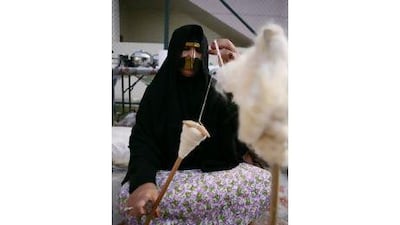ABU DHABI // Unlike the fairy tale of Sleeping Beauty, where the heroine falls into a deep, enchanted sleep after pricking her finger on a spindle, the weaver Afra Al Mansouri is reinvigorated each time she pierces one of her digits on the wooden spike.
"It jolts you back into a refreshed rhythm," said Mrs Al Mansouri, who was sitting recently inside a traditional tent, twirling and spinning a bundle of coarse, thick, white sheep wool into fine rolls of thread.
"The wool hurts your hands," the Emirati woman in her 40s said while rubbing her palms together.
"Thank Allah for the introduction of cotton into our weaving traditions," she said with a smile.
Mrs Al Mansouri, a member of the Al Manaseer desert tribe, is one of the few Emirati women who can skilfully weave Al Sadu, a handicraft practised by Bedouin women across the Arabian Peninsula.
Last month, Al Sadu was added to the United Nations Educational, Scientific and Cultural Organization's (Unesco) list of "intangible heritage" that is "in need of urgent safeguarding". The Abu Dhabi Authority for Culture and Heritage (Adach), which presented Al Sadu for inclusion on Unesco's Intangible Cultural Heritage list, hopes to raise international support for keeping the custom alive.
Traditional treasures can be found at the "handcraft section" inside the National Theatre in Abu Dhabi. Everything from baskets to dresses and rugs are for sale, handmade by the dozen or so weavers working for Adach. In the past several weeks, crafts with the colours of the national flag have been in demand as the UAE celebrates its 40th anniversary.
"Many of the expats come over to just sit and watch me spin wool," she said. "They say it is magical. It reminds them of the spindles they saw and heard about in fairy tales."
Only a handful of women from the desert tribes - mainly the Al Ruwashed, Al Ahbab, Al Manahel, Al Hawajer and Al Marri - know the craft but their numbers are dwindling: the new generations lack interest in the skill.
"My daughters know how to basically do it, but they don't love it like I do," said Mrs Al Mansouri.
The raw material for Al Sadu is shaved off of sheep, goats and camels, therefore its traditional colours are white, black and orange. The women sit in a circle, chatting as they weave geometric and floral designs. The wool is spun, dyed and then woven on a loom. Dyed wool was later introduced, with red, green, yellow, brown and white being woven into patterns. The "Al Owerayan" pattern is made up of an hourglass-like shape of two triangles. The "Asnan Al Khail" pattern is in the form of the square shape of horse teeth.
"You see this tent? This is what we would sit and make with our own hands," said Mrs Al Mansouri, pointing to the Bayit Al Shi'r, a wool-woven tent lined with triangular and rectangular shapes. The women would also weave covers for furniture, sacks and accessories for camels and horses. Depending on the complexity of the pattern and the size, a piece could take a weaver anywhere from a day up to two weeks to complete. Often, the ends of the threads would be tied up in a knot known as "tarboush".
"We didn't just keep a home clean and organised, we actually made one," she said.
Adach has begun preserving the craft through programmes. The few specialised weavers will teach younger generations how to make Al Sadu and other traditional crafts during visits to schools and even homes.
"It is truly one of our most beautiful handcrafts," said Safia Al Qubaisi, head of the handcrafts heritage section at Adach as well as head of heritage development and preservation.
"Thankfully, several of the tribes kept up this tradition, and so Al Sadu hasn't been lost to us when nomadic pastoral communities moved to the urban cities," said Mrs Al Qubaisi.
She also hopes that other traditional crafts get international recognition. Among them are "Al Ghoss" palm-leaf crafts and "Al Tali", a stripe that is wove from cotton and a golden or silver coloured palm leaf that is used in traditional women's wear.
"It is too bad that many women don't find the time to sit and weave or sew these traditional handcrafts," she said. "They are beautiful and very soothing."

